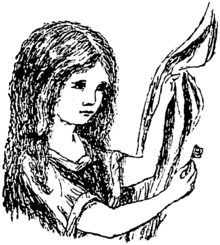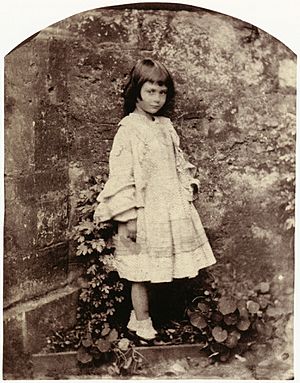Alice Liddell facts for kids
Quick facts for kids
Alice Liddell
|
|
|---|---|
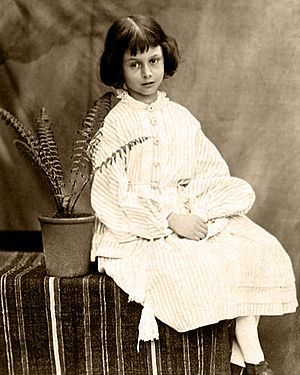
Alice Liddell, aged 7, photographed by Charles Dodgson (Lewis Carroll) in 1860
|
|
| Born |
Alice Pleasance Liddell
4 May 1852 Westminster, London, England
|
| Died | 16 November 1934 (aged 82) |
| Other names | Alice Hargreaves |
| Spouse(s) |
Reginald Hargreaves
(m. 1880; d. 1926) |
| Children | 3 |
| Parent(s) | Henry Liddell Lorina Reeve |
| Signature | |
Alice Pleasance Hargreaves (born Liddell; 4 May 1852 – 16 November 1934) was an English woman. When she was a child, she was a friend and often a subject for photographs taken by Lewis Carroll. One of the stories he told her during a boat trip later became the famous children's book Alice's Adventures in Wonderland in 1865. The main character in the book, "Alice", shares her name. However, experts don't fully agree on how much the book character was based on the real Alice.
Contents
Alice's Early Life
Alice Liddell was the fourth of ten children. Her father, Henry Liddell, was the head of Christ Church, Oxford, a college at Oxford University. Her mother was Lorina Hanna Liddell. Alice had two older brothers, Harry and Arthur, and an older sister named Lorina. She also had six younger siblings, including her sister Edith, who was a very close friend, and her brother Frederick.
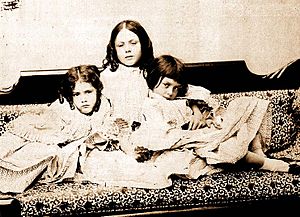
When Alice was born, her father was the headmaster of Westminster School. But soon after, her family moved to Oxford in 1856. There, Alice met Charles Lutwidge Dodgson, who is better known as Lewis Carroll. He met the family while taking pictures of the cathedral. Charles Dodgson became a good friend of the Liddell family over the next few years.
Alice, her older sister Lorina, and her younger sister Edith were always together as children. The family often spent their holidays at their home in Llandudno, North Wales.
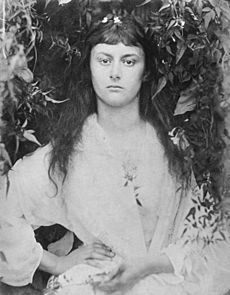
As a young woman, Alice Liddell traveled around Europe with Lorina and Edith. She became friends with Prince Leopold, Duke of Albany, who was the youngest son of Queen Victoria. He spent four years at Christ Church, Oxford. Years later, Prince Leopold named his first child Alice. He also became the godfather to Alice Liddell's second son, Leopold. It's also possible his daughter was named after his own older sister, Princess Alice of the United Kingdom. Alice's sister Edith passed away on June 26, 1876, shortly before she was going to get married. Prince Leopold was one of the people who carried her coffin at the funeral.
Alice's Later Life
Alice Liddell married Reginald Hargreaves on September 15, 1880. She was 28 years old. Reginald was a cricketer, a player of the sport cricket. They had three sons: Alan Knyveton Hargreaves, Leopold Reginald "Rex" Hargreaves, and Caryl Liddell Hargreaves. Sadly, Alan and Rex were both killed fighting in World War I. Caryl survived and later had a daughter. Alice said that her son Caryl's name was not connected to Charles Dodgson's pen name, Lewis Carroll. Reginald Hargreaves had a lot of money and was a local judge. Alice was known for hosting social events and was the first president of the Emery Down Women's Institute.
During World War I, she volunteered for the Red Cross. She received a medal for her work, which is now on display at the Museum of Oxford.
After her husband died in 1926, it became too expensive to keep their home. So, Alice decided to sell her special copy of Alice's Adventures under Ground. This was the original story that Lewis Carroll wrote before it became Alice's Adventures in Wonderland. The manuscript sold for a lot of money, much more than expected. It was later bought by a group of American book lovers and given to the British people. This was to show thanks for Britain's bravery during World War II. The manuscript is now kept at the British Library.
For most of her life, Alice lived in and around Lyndhurst in the New Forest area of England.
Alice's Death
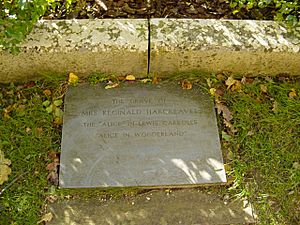
Alice Hargreaves passed away in 1934. Her body was cremated, and her ashes were buried in the churchyard of St Michael and All Angels in Lyndhurst, Hampshire. There is a special plaque there that calls her "Mrs. Reginald Hargreaves." Alice's mirror can be seen at the New Forest Heritage Centre in Lyndhurst, which is a free museum about the history of the New Forest.
How Alice in Wonderland Began
On July 4, 1862, Alice Liddell, who was 10 years old, was on a boat trip with her sisters Edith (8) and Lorina (13). They were traveling on the River Isis in Oxford for a picnic. Alice asked Charles Dodgson (Lewis Carroll) to tell them a story. As Reverend Robinson Duckworth rowed the boat, Dodgson told the girls amazing tales about a girl named Alice. This Alice fell into a rabbit-hole and had many adventures. Alice Liddell loved the story so much that she asked Mr. Dodgson to write it down for her. He promised he would, but it took him a few months to do it. He finally gave her the handwritten story, called Alice's Adventures Under Ground, in November 1864.
Later, Dodgson decided to make the story into a book that could be sold. He sent his manuscript to his friend, the author George MacDonald. MacDonald's children loved the story, which probably convinced Dodgson to find a publisher. Alice's Adventures in Wonderland, with drawings by John Tenniel, was published in 1865. It was published under the name Lewis Carroll. A second book about Alice, Through the Looking-Glass and What Alice Found There, came out in 1871. In 1886, the original handwritten story that Dodgson gave Alice, Alice's Adventures Under Ground, was also published.
Alice and Lewis Carroll's Friendship
The friendship between Alice Liddell and Charles Dodgson has been talked about a lot. Dodgson met the Liddell family in 1855. He first became friends with Alice's older brother, Harry. Later, he took Harry and Lorina on boat trips and picnics around Oxford. When Harry went to school, Alice and her younger sister Edith joined these outings. Dodgson would tell the children wonderful stories to pass the time. He also took many photographs of them, as photography was his hobby. While some people think Alice was his favorite subject, there isn't much proof of this. Some of Dodgson's diaries from that time are missing.
A Change in Friendship
In June 1863, the friendship between the Liddells and Dodgson suddenly changed. No one knows for sure why, because the Liddells never spoke about it openly. Also, a page from Dodgson's diary that covered June 27–29, 1863, is missing. Some people have guessed that Dodgson might have wanted to marry Alice Liddell, who was 11 years old at the time. They think this might have caused the sudden break in their friendship. Alice Liddell's biographer, Anne Clark, said that Alice's family believed Dodgson wanted to marry her. However, they felt Alice should marry someone with a better social standing.
In 1996, a note was found that seemed to summarize the missing diary page. This note was supposedly written by Dodgson's niece, Violet Dodgson. It suggested that the problem might have been about rumors linking Dodgson to the family's governess and to Lorina, Alice's older sister. Some experts think the note might have been a "censored version" of what really happened, to protect Lorina's feelings.
After this event, Dodgson avoided the Liddell home for six months. He eventually visited again in December 1863. However, their close friendship didn't seem to return, and it slowly faded away. This might have also been because Dodgson disagreed with Dean Liddell about college politics.
Alice in the Books
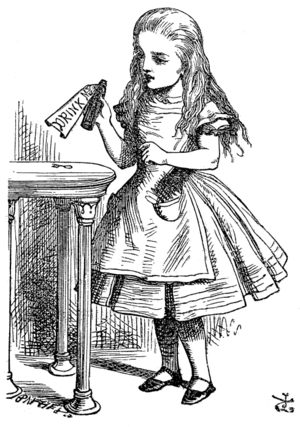
It's a debated topic how much the fictional Alice in the books is like the real Alice Liddell. The two Alices are clearly not exactly the same. For a long time, people thought the book character was based a lot on Alice Liddell. But newer research suggests this might not be entirely true. Dodgson himself later said that his Alice character was completely made up and not based on any real child.
There are at least four clear connections to Alice Liddell in the two books:
- First, the stories happen on May 4th (Alice Liddell's birthday) and November 4th (her "half-birthday"). In Through the Looking-Glass, the fictional Alice says she is "seven and a half exactly," which was Alice Liddell's age on that date.
- Second, Lewis Carroll dedicated the books "to Alice Pleasance Liddell."
- Third, in the first book, the Dormouse tells a story that starts, "Once upon a time there were three little sisters... and their names were Elsie, Lacie, and Tillie." "Lacie" is an anagram of "Alice." "Elsie" refers to Lorina, and "Tillie" was Edith's family nickname, Matilda.
- Fourth, there is a special poem at the end of Through the Looking-Glass. If you read the first letter of each line downwards, it spells out Alice Liddell's full name. This type of poem is called an acrostic. The poem is often called "A Boat Beneath a Sunny Sky."
A boat beneath a sunny sky,
Lingering onward dreamily
In an evening of July—
Children three that nestle near,
Eager eye and willing ear,
Pleased a simple tale to hear—
Long has paled that sunny sky:
Echoes fade and memories die.
Autumn frosts have slain July.
Still she haunts me, phantomwise,
Alice moving under skies
Never seen by waking eyes.
Children yet, the tale to hear,
Eager eye and willing ear,
Lovingly shall nestle near.
In a Wonderland they lie,
Dreaming as the days go by,
Dreaming as the summers die:
Ever drifting down the stream—
Lingering in the golden gleam—
Life, what is it but a dream?
Also, everyone who was on the boat trip where the story was first told (Carroll, Duckworth, and the three Liddell sisters) appears in the chapter "A Caucus-Race and a Long Tale." This is true if Alice Liddell is represented by the character Alice herself.
Alice Liddell in Other Stories
Alice Liddell has appeared in many other books, movies, and plays:
- She is the main character in Melanie Benjamin's novel Alice I Have Been, which tells a fictional story of her life.
- Michelle Rene's novel The Dodo Knight also focuses on Alice's friendship with Charles Dodgson.
- She appears in the Riverworld book series by Philip José Farmer.
- She has a small but important role in Lewis Padgett's short story "Mimsy Were the Borogoves".
- Katie Roiphe wrote a fictional book called Still She Haunts Me about Alice and Carroll's relationship.
- The 1985 film Dreamchild shows her trip to America and uses flashbacks to explore her relationship with Dodgson.
- The 2004 film Sincerely Yours, Lewis Carroll shows Alice and her sisters being photographed by Dodgson.
- Frank Beddor's The Looking Glass Wars reimagines the Alice in Wonderland story and includes real people like the Liddells.
- The 2008 opera Through the Looking Glass is about both the fictional Alice and Alice Liddell.
- Peter and Alice, a 2013 play by John Logan, shows Alice Liddell Hargreaves meeting Peter Llewelyn Davies, who inspired the character of Peter Pan.
- In Colin Greenland's science fiction novel Take Back Plenty, a spaceship named Alice Liddell is a main character.
- The Looking Glass House (2015), written by Alice Liddell's great-granddaughter Vanessa Tait, tells the story through the eyes of her governess.
- In the TV show Warehouse 13, Alice Liddell's spirit is trapped in Lewis Carroll's mirror.
- The stage play of Through the Looking-Glass by Jim Geisel is narrated by the historical Alice Liddell.
- Adrian Mitchell's 2001 stage play of Alice in Wonderland and Through the Looking-Glass includes Alice, her sisters, Dodgson, and Duckworth in the beginning and end.
- The video games American McGee's Alice and Alice: Madness Returns feature a character named Alice Lidell, who looks like the historical Alice.
Literature
- Björk, Christina; Eriksson, Inga-Karin (1993). The Other Alice. R & S Books.
- Clark, Anne (1982). The Real Alice. Stein And Day.
- Gardner, Martin (1965). Introduction to Alice's Adventures under Ground by Lewis Carroll. Dover Publications.
- Gardner, Martin (ed.) (2000). The Annotated Alice (The Definitive Edition). Allen Lane The Penguin Press.
- Gordon, Colin (1982). Beyond The Looking Glass. Harcourt Brace Jovanovich, Publishers.
- Gray, Donald J. (2005). The Norton Critical Edition of Alice in Wonderland. Donald J. Gray.
- Leach, Karoline (1999). In the Shadow of the Dreamchild. Peter Owens.
See also
 In Spanish: Alice Liddell para niños
In Spanish: Alice Liddell para niños




